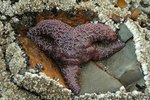
The purple sea urchin and the lined chiton share a commensal relationship. Biologically, this means one organism receives a benefit -- such as food, shelter or protection -- without either harming or benefiting the host organism. In this case, the smaller lined chiton receives the benefit of protection from the larger host, the purple sea urchin.
The Purple Kelp Eater
Purple sea urchins populate intertidal zones all along the Pacific Coast. Large numbers congregate around the holdfasts of kelp beds, where food is plentiful. Outside the Pacific kelp forests, purple sea urchins tend to live solitary lives. The round, symmetrical body of the purple sea urchin is covered in spines that are initially green tinged with purple as juveniles, then blossom into bright purple as adults. These spines guide food to the sea urchin's mouth, and work in combination with his tube feet for painstakingly slow locomotion across the ocean floor. The purple sea urchin can also use his sharp spines to pinch a predator in self defense. The mouth of the purple sea urchin holds five bony teeth, which he can use to burrow into rock or substrate. Many times, a juvenile sea urchin will create a burrow with an entrance too small for him to exit after he grows into an adult, trapping him for life.
The Little Gems of the Ocean
Beautifully colored mollusks, the oval-shaped shell of a lined chiton is made up of eight overlapping plates. Blue lines zigzag across a pink background, giving the lined chiton his name and making him one of the most striking-looking creatures in the sea. His color serves an important purpose, though, providing clever camouflage against the ocean floor. Ranging from the Aleutian Islands in the north to Baja California, Mexico in the south, the lined chiton inhabits intertidal and subtidal coastal areas. His single sucker foot helps him cling to rocky surfaces while he grazes on diatoms and algae.
Shared Predators
Predators of the purple sea urchin also enjoy feasting on the much more diminutive lined chiton. Sea stars and sea otters will happily dine on both creatures, and harlequin ducks will pluck the chiton from his rocky abode. The lined chiton has no self-defense mechanisms, so he often cohabitates with purple sea urchins and green anemones. He will tuck himself beneath the prickly protection of the purple sea urchin, finding a safe haven in a dangerous ocean.
Rocky Roommates
Many times, the lined chiton will crawl into a burrow excavated by a purple sea urchin. If the urchin is in residence, his sharp spines provide a layer of protection. If the urchin has abandoned his burrow, the lined chiton can use the space to remain out of the grasp of his predators.
References
Photo Credits
-
Liquidlibrary/liquidlibrary/Getty Images



